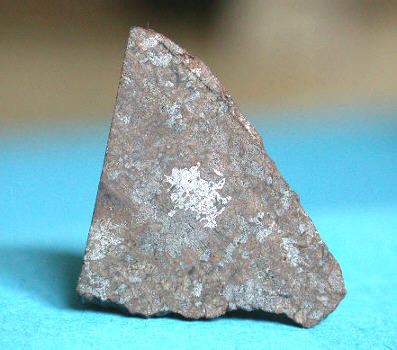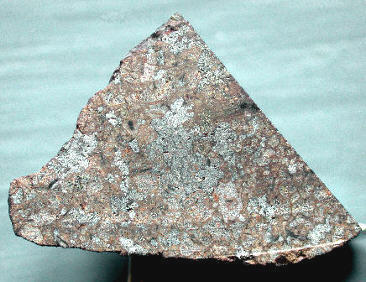Ureilite
Monomict/Unbrecciated
Olivine–augiteHigh-Ca clinopyroxene, (Ca,Mg,Fe)SiO3, that occurs in many igneous rocks, particularly those of basaltic composition. In order to be considered augite, the clinopyroxene must contain 20 to 45 mol % of calcium (Wo20 - 45). An important and unique Martian meteorite is NWA 8159, that has been classified as an augite basalt. Click on Term to Read More

Found 1994
28° 46.66′ N., 12° 20.13′ E. A single stone weighing 136 g was found in the Libyan Sahara, and was classified at the Institut für Planetologie in Münster as a pyroxene-rich (pyroxeneA class of silicate (SiO3) minerals that form a solid solution between iron and magnesium and can contain up to 50% calcium. Pyroxenes are important rock forming minerals and critical to understanding igneous processes. For more detailed information, please read the Pyroxene Group article found in the Meteoritics & Classification category. Click on Term to Read More/pyroxene + olivineGroup of silicate minerals, (Mg,Fe)2SiO4, with the compositional endpoints of forsterite (Mg2SiO4) and fayalite (Fe2SiO4). Olivine is commonly found in all chondrites within both the matrix and chondrules, achondrites including most primitive achondrites and some evolved achondrites, in pallasites as large yellow-green crystals (brown when terrestrialized), in the silicate portion Click on Term to Read More = 65 vol%), unbrecciated ureilite. It has been weathered to grade 3 and exhibits only weak shock features (S3), as reflected in planar fractures and undulatory extinctionIn astronomy, the dimming of starlight as it passes through the interstellar medium. Dust scatters some of the light, causing the total intensity of the light to diminish. It is important to take this effect into account when measuring the apparent brightness of stars. The dark bands running across portions Click on Term to Read More in the silicates. However, the presence of possible shock-produced diamonds within carbon-rich areas suggests that some shock features might have been erased during annealing.
Hammadah al Hamra 064 is a member of a small subgroup of ureilites, the olivine–augite type, which comprises less than ~10% of the known ureilites. A third type, the olivine–
orthopyroxeneOrthorhombic, low-Ca pyroxene common in chondrites. Its compositional range runs from all Mg-rich enstatite, MgSiO3 to Fe-rich ferrosilite, FeSiO3. These end-members form an almost complete solid solution where Mg2+ substitutes for Fe2+ up to about 90 mol. % and Ca substitutes no more than ~5 mol. % (higher Ca2+ contents occur Click on Term to Read More ureilites, has been identified in the ureilite classification scheme proposed by Goodrich
et al. (2006). The olivine–augite ureilites formed as cumulates rather than residues, in late-stage, highly refractory melt pools. They crystallized at a range of depths in close association with the much more common olivine–
pigeoniteLow-Ca clinopyroxene, (Ca,Mg,Fe)SiO3, found as a major mineral in eucrites and shergottites. In order to be considered pigeonite, the clinopyroxene must contain 5 to 20 mol % of calcium (Wo5 - 20). Chondrites of petrologic types 4 and below contain significant low-Ca clinopyroxene. During metamorphism to higher temperatures, all existing ureilites. The olivine–pigeonite type of ureilites, which exhibit the typical texture of residues of low degree fractional melts, constitute ~90% of the known ureilites. Two transitional members are also known, RKPA80239 and PCA 82506, which have textures that are intermediate between the typical and poikilitic groups. Ureilites in the small augite- and orthopyroxene-bearing subgroups were found to contain primary trapped melt inclusions, demonstrating a complex magmatic history (Goodrich
et al., 2000).
Hammadah al Hamra 064 has a bimodal texture and contains ~5–10 vol% augite. One lithology has a typical ureilite texture consisting of mm-sized augite and olivine grains, with grain boundaries forming 120° triple junctions. These grains are separated by metal-rich veins and an
interstitialTerm applied to ions or atoms occupying sites between lattice points. Click on Term to Read More, fine-grained, carbon-rich (primarily
graphiteOpaque form of carbon (C) found in some iron and ordinary chondrites and in ureilite meteorites. Each C atom is bonded to three others in a plane composed of fused hexagonal rings, just like those in aromatic hydrocarbons. The two known forms of graphite, α (hexagonal) and β (rhombohedral), have Click on Term to Read More)
matrixFine grained primary and silicate-rich material in chondrites that surrounds chondrules, refractory inclusions (like CAIs), breccia clasts and other constituents. Click on Term to Read More. The other lithology is composed of olivine and augite poikilitically enclosed within large (≥5 mm) pigeonite (Wo ~4.5, and more accurately described as orthopyroxene; Goodrich
et al., 2006) crystals constituting ~50 vol%, with low-Ni metal-rich veins occurring between constituents. This poikilitic lithology is thought to have been produced when an assemblage of cumulus olivine and augite experienced
reductionOxidation and reduction together are called redox (reduction and oxidation) and generally characterized by the transfer of electrons between chemical species, like molecules, atoms or ions, where one species undergoes oxidation, a loss of electrons, while another species undergoes reduction, a gain of electrons. This transfer of electrons between reactants Click on Term to Read More during the ascent of a relatively ferroan
magmaMolten silicate (rock) beneath the surface of a planetary body or moon. When it reaches the surface, magma is called lava. Click on Term to Read More from deep source regions. This augite-bearing magma was ultimately assimilated into the olivine–pigeonite residues located at shallower levels (Goodrich and Fioretti, 2007; Goodrich
et al., 2009). Alternatively, the orthopyroxene may have been introduced by integration of an orthopyroxene-saturated magma. Another possible route to orthopyroxene formation is by the transformation of pigeonite as the rock experienced an increased cooling rate below the equilibration temperature of ~1200°C (Weber
et al., 2003).
During the ascent stage of the parent magma within the conduit, the olivine in augite-bearing ureilites began to crystallize first, followed by augite and orthopyroxene as the magma reached shallower levels (Goodrich
et al., 2009). Olivine is surrounded by reduction rims up to 0.1 mm wide which are composed of pure
forsteritePure* magnesium end-member (Mg2SiO4) of the olivine solid solution series and an important mineral in meteorites. When magnesium (Mg) is completely substituted by iron, it yields the the pure Fe-olivine end member, fayalite (Fe2SiO4). The various Fe and Mg substitutions between these two end-members are described based on their forsteritic (Fo) Click on Term to Read More in the outer layers. These rims contain miniscule spherical
metalElement that readily forms cations and has metallic bonds; sometimes said to be similar to a cation in a cloud of electrons. The metals are one of the three groups of elements as distinguished by their ionization and bonding properties, along with the metalloids and nonmetals. A diagonal line drawn Click on Term to Read More grains,
silicaSilicon dioxide, SiO2., graphite flakes, and protoenstatite grains along with occasional orthopyroxene. They were probably formed through a smelting process involving silicates and graphite that was initiated by a sudden pressure drop accompanied by rapid cooling. An alternative lower-temperature smelting reaction involving methane was proposed by Langendam and Tomkins (2012) to explain the observed smelting within fractures and the discontinuous smelting at grain boundaries; their scenario also supports the concept of
chemical vapor depositionMethod for growing solids in which a gaseous precursor (containing fragments of the desired solid) is decomposed and deposited onto a desired surface. Chemical Vapor Deposition (CVD) is one of the most powerful synthetic methods in material science due to its remarkable flexibility. A variety of surfaces can be coated, Click on Term to Read More (CVD) of
diamondOne of the naturally occurring forms of carbon found in meteorites. Each C atom is bonded through covalent sp3 hydrid orbitals to four others. The strength of the C-C bonds makes diamond the hardest naturally occurring substance (according to the Mohs scale) in terms of resistance to scratching. There are Click on Term to Read More. Spinodal decomposition of augite also attests to a relatively rapid cooling rate (15–20°C/hr) from high temperatures. A final sudden increase in the cooling rate may have been the result of a collisional disruption of the UPB.
The ureilites of the olivine–augite type define a broad range of Δ
17O values, consistent with their formation at varied depths on the
parent bodyThe body from which a meteorite or meteoroid was derived prior to its ejection. Some parent bodies were destroyed early in the formation of our Solar System, while others like the asteroid 4-Vesta and Mars are still observable today. Click on Term to Read More. This subgroup of ureilites (known as the ‘Hughes cluster’) comprises a small number of samples, including the following: Hughes 009
HaH 064
ALH 82106/82130/84136
EET 96293/96314/96331
EET 87511/87523/87717
EET 87517
META78008
LEW 88774
LEW 85440/88012/88201/88281
Y-74130
FRO 90054/90228/90233/93008 (aug-bearing clasts)
DaG 999 (single aug-bearing
clastA mineral or rock fragment embedded in another rock. Click on Term to Read More)
Y-74123 (aug within melt veins)
Y-790981 (aug within melt veins)
Calama 001
NWA 3222 (37–41 vol% augite)
Ramlat as Sahmah 530 (aug-bearing)
NWA 11900 (aug-bearing) In an attempt to identify possible common ejection events among the ureilites, Beard and Swindle (2017) conducted a comparative study of 39 different samples utilizing three parameters: CRE age, Fo content in olivine (Mg#), and Δ
17O value. They resolved ten potential clusters, several of which show concordance in their CRE age and Mg# but not in Δ
17O value (heterogeneous), and three that are concordant in all three parameters (homogeneous). The youngest heterogeneous cluster reflects an ejection event that occurred 0.7 (±0.1) m.y. ago and comprises HaH 064 and Acfer 277.
A cohesive model for the petrogenesis of the ureilites was presented by Goodrich
et al., LPSC XXXIII,
#1379 (2002), which was followed by important modifications in subsequent publications (Goodrich
et al., 2007), some details of which can be found on the
Kenna and
Almahata Sitta pages. The specimen of HaH 064 shown in the photos above and below is a 4.23 g partial slice that was sectioned from the portion curated at the Museum für Naturkunde, Humboldt University, Berlin.

click on photo for a magnified view

Photography courtesy of Stephan Kambach
Ureilites are finally figured out! >>click here









